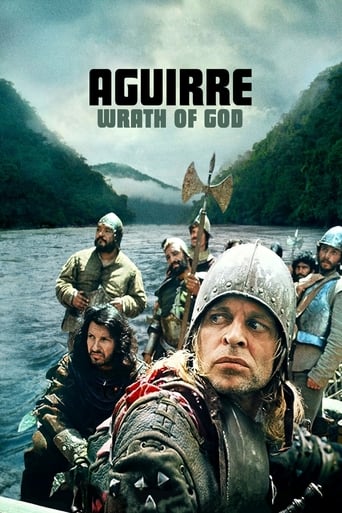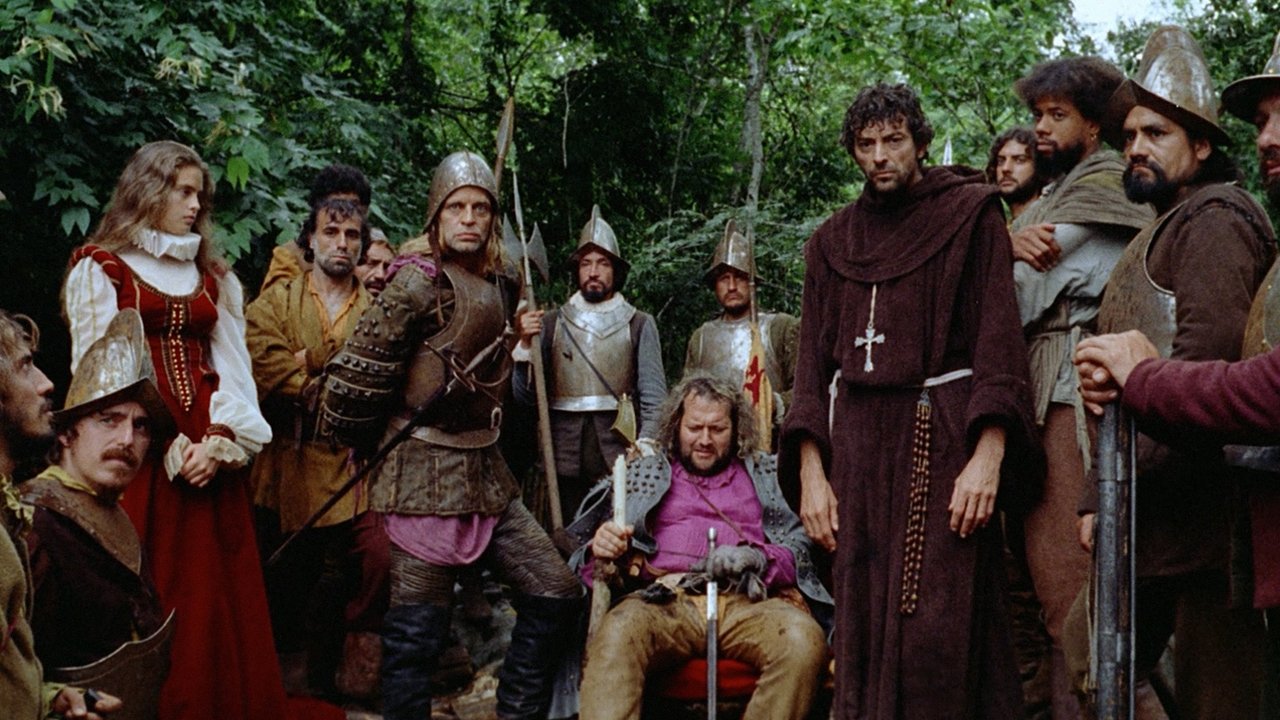classicsoncall
Coming off a recent vacation trip to Costa Rica, I was struck by the similarity of the Peruvian locations serving as the backdrop to this story. Our tour group had a couple of rain forest hikes along with two wildlife spotting river cruises, and if I didn't know better, I would have pegged the muddy brown, tranquil river in the movie as the Rio Frio. What struck me though was that the long views of the riverbanks in the picture offered no animal or bird life, which was in abundance on my excursions. Anyway, enough of that.The film begins with an impressive looking descent down a steep mountain pass, and as a harbinger of things to come, director Herzog chooses to focus his camera on long establishing shots, often times unnecessary as in the drawn out view of the turbulent river rapids early in the story. These serve to pad out the length of the picture, which is only a tad over an hour and a half to begin with. With the title acknowledging that the principal character is named Aguirre, it takes some time for Klaus Kinski to initiate the mutiny that takes over the expedition hunting for the mythical El Dorado, the ancient Inca Lost City of Gold. Aguirre is a fanatic, but allows some semblance of composure as second-in-command while undermining the authority of both the original leader Gonzalo Pizzaro (Alejandro Repullés), as well as that of Don Pedro de Ursua (Ruy Guerraas), the leader of the smaller expeditionary group.What's perhaps most revealing in the story is how difficult it must have been in an a pre-machine age for explorers to make their way through uncharted jungle territory. Watching men drag along cannon and Ursua's mistress (Helena Rojo) aboard a throne-like sedan chair seemed like an incredible waste of energy that eventually ended in a failed mission. And then one has to consider that the director, actors and film crew had to endure these same hardships for the sake of their craft. A 'making of' picture detailing the effort probably would have been as compelling as the film's narrative.I'd consider myself a Klaus Kinski fan, even though I've mainly seen him only as a villain in off-beat Western movie roles. He doesn't quite carry the entire picture here as the principal actor, but his presence does create an eclectic magnetism of a man obsessed by the idea of power, fame and riches. As his men are decimated by unseen arrows, spears and poison darts, his fateful descent into madness is complete, forever to be defeated by the relentless force of an unforgiving environment.
kristiangunn
A visually stunning film. Shot on location and breathtaking in its photography. My only issue was that many of the close up shots or scenes looked as if they had been recorded on VHS like some 80's home movie. Klaus Kinski absolutely owns every shot in which he is featured; incredibly striking looking chap, though you did wonder whether the helmet was completely necessary for the entirety of the film considering the Amazonian conditions! Would have been an 8 for me, but too many cheap looking shots spoiled it slightly. Maybe there's a remastered version out there I should have watched instead?
Brian Berta
When I looked at a summary of what this film would be about, I assumed that it was going to be a fast-paced action film. However, what I got was something entirely different. This film felt unique compared to other survival films, and I don't think that many other directors would be able to make it as good as good as Werner Herzog did. This is a kind of a film which gets more mysterious the more I think about it.In 1560, hundreds of Spanish conquistadors leave their home in the Andes mountains in search of the fabled country of El Dorado. Running low on supplies, 40 men are ordered to scout ahead by a raft on a river. If they don't return in one week, they will be considered lost, and everyone else will return without them. However, their expedition proves to be more and more dangerous as the days go by.As I said above, I was expecting something completely different. I was expecting a typical fast paced action/survival film. Instead, this movie had very few battle scenes. Most of the action showed a character hit by an arrow or die off-screen. We sometimes saw glimpses of Indians or heard gunfire in the distance, but every time a character was killed by the Indians, the enemy was always unseen. I feel like Herzog's reason for filming the action like this was to show how vulnerable the Spaniards were. It was almost like he was letting the audience know that they stood no chance against the Indians. This aspect also applies to other areas. For instance, after a group of people become untrusting of their leader Guzman, he is found mysteriously dead moments later. Another great scene is when one of the characters walks off into the jungle never to be seen again. However, the best use of this aspect involves the large group of people who waited for the 40 men to come back. Since they were never seen again in the film, it raised the possibility that they might be either struggling with the Indians or are already dead. I'd say that despite the exception of a single scene and a single line of dialogue, the action was perfect.The character of Aguirre is hard to describe. The reason I say this is because it's hard for me to decide whether he was meant to be a protagonist, an anti-hero, or a villain. If I had to choose, I'd say that he falls somewhere in the middle of being an anti-hero and a villain. He seemed like a character who cared about nothing more other than having everything done the way he wants and discovering El Dorado at all costs no matter how much of his men are still alive. He didn't seem to care about the fate of his crew (except for maybe his daughter). If any of his men would try to defy him, he wouldn't hesitate to end their life. A great plot point that given us insight to how mysterious Aguirre's character is was how he wanted Ursua to die. After Ursua is sentenced to death, the leader of the group (Guzman) prevents him from dying (an action which clearly infuriates Aguirre). After Guzman's mysteriously killed off, however, there's nothing stopping Aguirre from executing the man. With that being said, I feel like Aguirre killed Guzman, because that way, he'd be able to kill Ursua without anyone stopping him. Guzman's death seemed convenient for Aguirre. Aguirre is definitely one of the more memorable movie characters I've seen in a while.The visuals in this movie are also worth noting. They feel both awe-inspiring and unsettling. A great example of its visuals is the intro to the film. It does a great job introducing us to the environment the film takes place in. When the film starts off, we see hundreds of men and women marching down narrow paths in the mountains. The scope of this shot is amazing as it lets the audience know how insignificant the men are compared to the terrain they're walking across. It also gives you a feeling that the Spaniards and the Indians will encounter numerous hardships during their expedition. Another scene that has a similar feel to the intro is when we see the rafts floating down heavy rapids in the river. Both of these scenes show that Herzog isn't afraid of risking his crew's life just to make a film.There are also a few haunting visual set pieces. One of these scenes occur near the end when the Spaniards see a ship up in the trees. All of them react differently to it. One person thinks that it's a hallucination while another person thinks that it's real. Aguirre tells his crew to bring the ship down so they can use it to sail to the Atlantic, but one member of Aguirre's crew immediately refuses to do so - this is one of the only times in the film where a character disobeys Aguirre. This is a disturbing scene as it shows us how weak the mental state is of the remaining crew members. Another memorable scene is the ending where monkeys overrun the raft. That scene shows how Aguirre has been conquered by nature.In conclusion, I was pleasantly surprised with this film as it turned out to be completely different than how I imagined it would be. It's a brilliant film. It may not quite reach perfection, but it's still an outstanding and a unique film. The action scenes feel unsettling, Aguirre was a memorable villain, and the visuals evoked different moods from me. I'll be sure to keep an eye out for Herzog in the future.
Jackson Booth-Millard
I had known about this West German film for a few years, mainly through seeing images from it, and its inclusion in the book 1001 Movies You Must See Before You Die, I was relieved when I finally got the opportunity to watch it, directed by Werner Herzog (Fitzcarraldo, Nosferatu the Vampyre, Grizzly Man). Basically set in the 16th century, in the year 1560, decades after the destruction of the Inca empire, a Spanish expedition of ruthless conquistadors leave the mountains of Peru. The band are under the command of Gonzalo Pizarro (Alejandro Repullés), with Don Lope de Aguirre (Klaus Kinski) as second-in-command. They are travelling down the Amazon river in search of gold and fortune, but the journey rapidly becomes more perilous, and loyalty deteriorates when the ruthless and insane Aguirre overthrows the group's leader. Aguirre is obsessed and only cares about riches, he is leading the band on a potentially unending and fanatical search for the lost "golden city" of El Dorado, his madness and the inhospitable environment mean that this mission will only end in failure and destruction. Also starring Cecilia Rivera as Flores, Ruy Guerra as Lieutenant Don Pedro de Ursua, Helena Rojo as Inez, Del Negro as Brother Gaspar de Carvajal, Peter Berling as Don Fernando de Guzman, Armando Polanah as Armando, Daniel Ades as Perucho and Edward Roland as Okello. Herzog regular Kinski dominates the film as the rebellious and unhinged commander who will do whatever it takes to get what he wants, it is a simple story of a doomed medieval style treasure hunt, with an overwhelming weirdness at times, but with the jungle and river locations, it makes for marvellous viewing, I admit I trailed off a little at times, but I got the overall gist, it is a watchable period drama. Good!



 AD
AD








